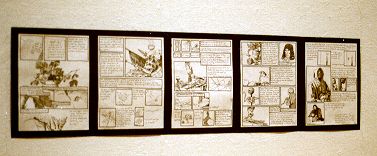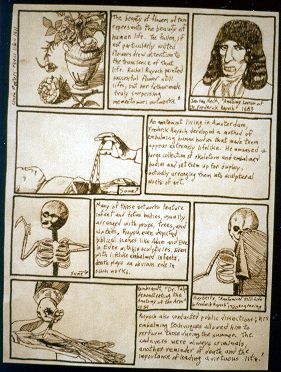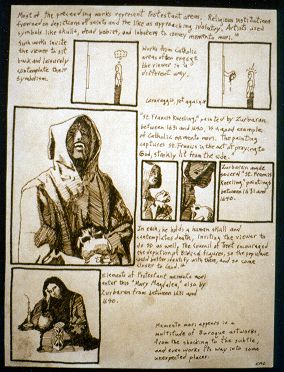
Memento Mori
A research paper in art historyMatiss presented this version, as a poster, at a student symposium.
The original paper has typed footnotes and a bibliography.
The medium is pen and ink.
 |
Memento Mori! Memento Mori works are often contemplative, occasionally shocking, and appear in Baroque art across genre and national boundaries. Caravaggio's still life "Basket of Fruit" is an early Baroque example of Memento mori. From a distance, it appear a normal and quite realistic still life. A closer inspection, however, reveals worm-eaten fruit, and eaten and dying leaves. In Caravaggio's hands, decay touches even the fruit that normally symbolizes fertility and bounty. |
 |
Still life painting was not very popular in Italy, and memento mori appears much more often in Dutch works of this genre. The prevalent approach to these paintings considers them "vanitas," of moral works intended to remind the viewer of the transience of human existence. Such works generally juxtapose symbols of mortality with worldly goods. Jan Vermewen's "Vanitas" of 1654, a detail of which is above, serves as a wonderful example of this style of still life. Unlike the Caravaggio still life, where death symbolism appreaches stealthily, Vermewen's still life hits the viewer with death immediately. The spear and flagpole points, together with the skull's gaze, form a strong diagonal. The light source follows that same diagonal back to emphasize the skull. In a similar format to another Caravaggio painting, Death (as opposed to Love here), appears triumphant over symbols of worldly aspirations: books for knowledge, crowns for power, musical instruments for love and so on. "Death Conquers All" "Vanity of vanities, all is vanity." |
 |
Other objects besides the skull add memento mori to Dutch still lifes. The sand timer, oil lamp, and watch serve to remind the viewer of the transitory nature of human life, and of the need to tend to the spiritual before the sorldly in preparation for the afterlife. As unlikely as it may seem, the lobster may have been a symbol of humanity in the midst of temptation. If we imagine it alive... and therefore grant it the ability to move.. where will our lobster go? It may go to the food (gluttony), or to the riches (greed), or to any of the other moral pitfalls in a person's journey through life. Like the lobster, we must choose carefully. |
 |
The beauty of flowers often represents the beauty of human life. The fallen, if not particularly wilted flowers drew attention to the transience of that life. Rachel Ruysch painted successful flower still lifes, but her father made truly surprising memento mori artworks. An anatomist living in Amsterdam, Frederik Ruysch developed a method of embalming human bodies that made them appear extremely lifelike. He amassed a large collection of skeletons and embalmed bodies and set them up for display, actually arranging them into sculptural works of art. Many of these art works feature infant and fetus bodies, usually arranged with props, trees and clothes. Ruysch even depicted biblical scenes like Adam and Eve in Eden with his sculptures. Even with lifelike embalmed infants, death plays an obvious role in such works. Ruysch also conducted public dissections; his embalming techniques allowed him to perform these during the summer. The cadavers were always criminals, another reminder of death and the importance of leading a virtuous life. |
 |
Most of the preceding works represent Protestant areas. Religious institutions frowned on depictions of saints and the like as approaching idolatry. Artists used symbols like skulls, dead babies, and lobsters to convey memento mori. Such works invite the viewer to sit back and leisurely contemplate their symbolism. Works from Catholic areas often engage the viewer in a different way. "St. Francis Kneeling," painted by Zurbaran between 1631 and 1640, is a good example of Catholic memento mori. The painting captures St. Francis in the act of praying to God, starkly lit from the side. Zurbaran made several "St. Francis Kneeling" paintings between 1631 nad 1640. In each, he holds a human skull and contemplates death, inviting the viewer to do so as well. The Council of Trent encouraged the depiction of Biblical figures, so the populace could better identify with them, and so come closer to God. Elements of Protestant memento mori enter this "Mary Magdalen," also by Zurbaran from between 1631 and 1640. Memento mori appears in a multitude of Baroque artworks, from the shocking to the subtle, and even works its way into some unexpected places. |
Poem | Residue | Paleontology | Memento Mori